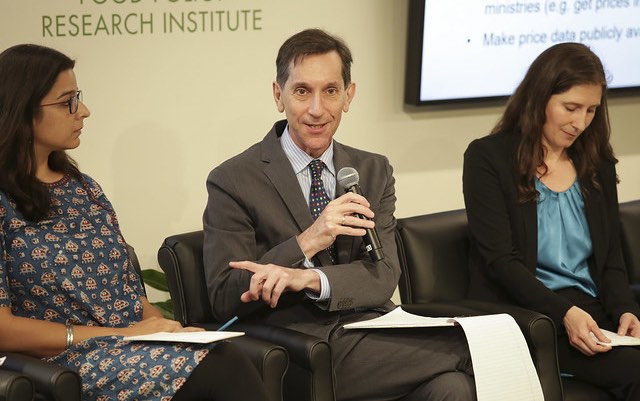Is healthy eating becoming more affordable on a global scale? Consumers in places like Africa and South Asia are experiencing rapid changes in their local food systems as incomes rise and prices fluctuate. This shifting landscape has posed many questions for global nutritional outcomes, prompting new research into the cost of maintaining a healthy diet. A May 29 IFPRI policy seminar explored this issue, focusing on the Tufts-IFPRI project Changing Access to Nutritious Diets in Africa and South Asia (CANDASA) .
That effort has kick-started new ways of measuring food prices by examining the everyday cost of maintaining nutritionally sound eating habits, casting light on how food systems in Africa and South Asia are changing, and the ways that food policy must be adapted to make better diets affordable.
Principal investigator and Tufts Professor William A. Masters explained the importance of monitoring fluctuations of food prices: “We are trying to measure the cost of nutritious diets because we want to monitor the changing access to nutritious diets.” As incomes grow, Masters said, people gain access to more branded, packaged items—a transition away from bulk commodities and foods prepared at home. To find out how this shift has impacted diets, CANDASA researchers built on foundational cost-per-calorie studies and analyses by aid organizations often used to recommend nutritionally sound, least-cost diets. The resulting analysis tracked the prices of nutritious food items through the lens of affordability.
Food price data is fairly accessible, noted CANDASA co-investigator Anna Herforth. Many organizations use this data for broad economic analysis, or to monitor food security by watching the prices of commonly-consumed staple food items. The new research goes beyond these types of analyses. Two new indicators examine real-world links between food prices and nutrition. The first is the Cost of Recommended Diet index, which measures the cost of following recommended diets at the national level. Herforth noted that this particular index “is important for policy coherence because food-based dietary guidelines are part of national policy and are used in education, but all the education in the world can’t help if these diets are not affordable to certain segments of the population.” Researchers also employed a second Cost of Nutrient Adequacy index to assess the lowest possible cost of meeting calorie and macro/micronutrient needs.
But in looking closer, new questions arise: Are these costs borne equally among all people in a given food system? Tufts PhD students Yan Bai and Kate Schneider outlined the individual differences in meeting caloric and micro/macronutrient needs across ages and genders. Schneider noted that these differences, like higher lipid intake requirements for toddlers, or higher vitamin A intake for breastfeeding women, mean that “different age and gender groups face different costs” in following a diet adequate for their particular life stage.
These costs also vary by place and time. Stevier Kaiyatsa, an economist at the Malawi Ministry of Finance, Planning & Development, showed that the cost of providing both calorically and nutritionally adequate diets differs across urban and rural markets—with urban settings often being the more expensive of the two. Fulgence Mishili, a senior lecturer at the Sokoine University of Agriculture in Tanzania, noted the impact of seasonal prices, which not only vary throughout the year, but are also felt unequally across regions. For example, the southern areas of Tanzania face higher seasonal rises in costs of nutritionally adequate diets than other regions.
In Ethiopia, IFPRI Research Coordinator Fantu Bachewe noted incomes have risen in recent years, and so the cost of calorically and nutritionally adequate diets have fallen in relation to wages. Meanwhile, in India, the least-cost diet has stabilized at about $0.50 per day. But despite recent improvements to wages, this price point is often prohibitively expensive for a significant part of the population—especially for women. IFPRI Research Fellow Kalyani Raghunathan stressed that the costs of fulfilling dietary needs hit Indian women harder than men: “They constitute about 70 to 80% of women’s wages, and only about 50 to 60% of men’s wages.”
How do we address this uneven access to nutritious foods? Daniel Sarpong, an associate professor and dean at the School of Agriculture at the University of Ghana, detailed how these findings might influence policy decisions. To start, this research can be applied to routine food price monitoring by government agencies. In Ghana, this has provided the impetus for informal meetings of a Nutritious Food Prices Analysis Support Group, hosted at the University of Ghana, which convenes statistical officers and local economists to interpret current food price data.
Beyond capacity building, IFPRI Senior Research Fellow Derek Headey noted that “food system changes could make healthier diets more affordable for all.” To improve access to nutritious diets, stabilizing food prices will be of vital importance, especially for low-income populations for whom the costs of maintaining a nutritionally adequate diet typically exceed earnings. But this fact is often missed in traditional food price analysis: While most countries monitor food prices at large, they do not take the cost of meeting nutritional needs into account.
To both collect and put this new food affordability data to work, cross-agency collaboration (i.e. between agricultural and statistical ministries) must be strengthened. Even today, the data is imperfect—this type of collaboration must center on continual refinement of the data, eliminating challenges like what Headey called the “urban bias.”
To improve the affordability of healthy diets is no small feat. For consumers, CANDASA research shows that the food landscape is uneven and often volatile. But by pioneering new methods of monitoring food prices, CANDASA researchers have paved a path toward food policy that makes healthful eating attainable.
Katherine Peinhardt is a freelance writer.







